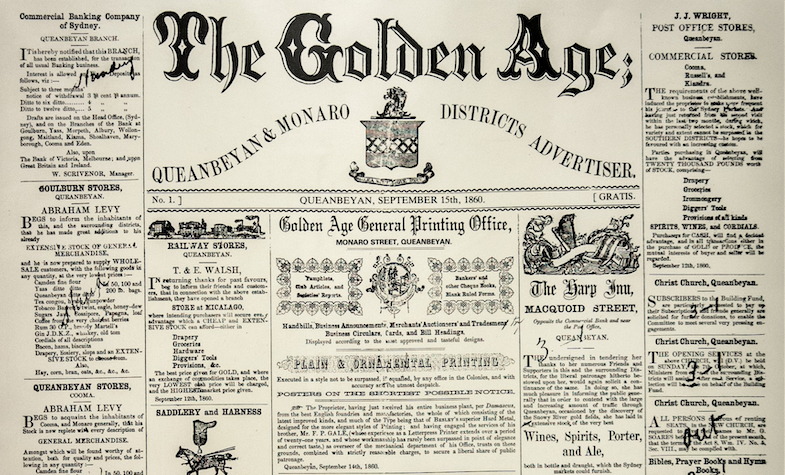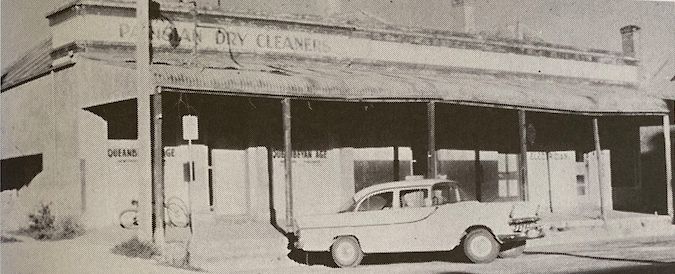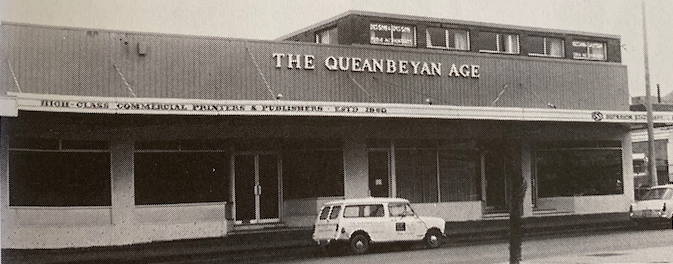
“Yesterday’s” columnist NICHOLE OVERALL looks back at the long and distinguished history of the “Queanbeyan Age”. After 160 years its publication has been suspended and the prospect of coming back next month looks bleak…
IT’S one of the oldest surviving newspapers in Australia, having even served the national capital, but “The Queanbeyan Age” may have had its final print run as one of more than 200 regional and rural papers throughout the country to have fallen victim to a virus.

It also comes in the face of the $50 million regional journalism rescue package announced by the federal government in response to the COVID-19-induced shutdowns.
In 160 years of continuous publication, the “Age” has managed to stay afloat and act as district informer during other global disasters including two World Wars, the Influenza Pandemic of 1918-19 (Spanish Flu) and a decade of economic instability following the Great Depression in 1929.
As the third newspaper established in the wider area – “The Goulburn Herald” appearing in 1848 (absorbed by “The Goulburn Evening Penny Post” of 1870), followed by “The Yass Courier” in 1857 (until 1929) – it’s outlasted as many as five other Queanbeyan papers to variously report on local happenings (in the early 1900s, the town supported three at once!). It even survived the arrival of “The Canberra Times” in 1926.
Times though, “are a changin,” and in mid-April “The Queanbeyan Age” joined the vast number of “non-daily” titles suspended from appearing in print. One of a stable of mastheads owned by Australian Community Media (ACM), the former Fairfax holding sold just last year, new executive chairman Antony Catalano stated the measures would be in place until the end of June.
A door has closed on history, and what are the chances it will be reopened?
Trudy Taylor, Queanbeyan-Palerang Regional councillor, former editor of the local press icon and granddaughter of the well-known owner-editor from 1958, Jim Woods, is concerned by what the decision means for the industry.

“My grandfather, a newspaperman to his core, would be turning in his grave,” she says from her home in Googong. “It’s a very sad thing to see.”
“Papers like this, they’re an integral part of the fabric of a community. For more than a century-and-a-half, ‘The Queanbeyan Age’ has been there reporting on everything from local births, deaths and marriages to the ups and downs of life in our community. It’s more than just news, it’s a tangible reflection of who we are and what’s important to us.”
Social media commentary has echoed the sentiments, suggesting such actions “hit at the core of community belonging”.
“It’s fine to say they’re publishing some digital content, but that doesn’t offer the same sense of engagement,” says Trudy.
“The need for news and information at a local level, from people based locally and who know what’s going on, is vital.
“Remote journalism, with even less journalists available to do the job, and some paywalls on top of that, aren’t positive signs for the future of regional media”.
Queanbeyan had long been a leading source of local news in the wider region by the time Canberra came into being in 1913 – and remained so well after.

It was 1924 before the “Federal Capital Pioneer” appeared, predecessor to the Shakespeare family’s “The Canberra Times” two years later.
By 1927, the capital’s own newspaper moved from a weekly to a bi-weekly. It cost 3 pence ($1 today), totalled 16 pages and boasted a circulation up to 10,000 – despite the fact the population was less than 7000 in that period.
Back in Queanbeyan, the primary competitor of the “Times” had a 66-year head start.
It had been the 1860 brainchild of Methodist minister turned writer, John Gale.
“The Golden Age” was established to take advantage of the brief Kiandra gold rush. A few years later, the name was changed to the one the paper still bears after mergers, location adjustments and ownership changes.
Originally a four-page broadsheet, the “Age” featured regional correspondents from Ginninderra to Goulburn. It also employed those who’d become known names, including poet Victor J Daley, a contemporary of Henry Lawson.
Gale – later dubbed the “Father of Canberra” for his role in seeing the national capital sited in the backyard of his adopted hometown – also ran other newspapers throughout the area. Among them, “The Braidwood Independent”, “The Bungendore Mirror” and “The Captain’s Flat Miner”.
The extensive operation was a family affair – as it would similarly become on its acquisition by Lial James “Jim” Woods (in partnership with Arthur and Jack Bradley) 100 years after its first editor settled in Queanbeyan.
Despite Gale’s conservative views – he was a strict tee-totaller, a stalwart Freemason and a man who didn’t believe in sport on Sundays – he gave his daughters opportunities that would have been revolutionary in the day.
Annie, Eva and Minnie, all still in their teens, became compositors (arranging text for printing). Given it was the 1870s, my research suggests they were some of the first women in Australia to be employed in such an occupation.
In addition, Annie (later, Mrs Fallick) became an editor – potentially the youngest female ever at just 18 – and proprietor of her own newspaper, “The Queanbeyan Observer” (I’m writing further about these remarkable women, so stay posted).
In the meantime, the original town paper assumed other local efforts, from “The Queanbeyan Times” to the “Queanbeyan-Canberra Advocate” and eventually joined forces with “The Observer”. At one point popular enough to be produced three times a week, it more-or-less remained a Gale-Fallick-Woods dynasty until its sale in 1994 to “the nation’s largest publisher to country Australians”, Rural Press Limited.
In 2016, it was incorporated with “The Chronicle” by Fairfax, and after 156 years, its Queanbeyan office closed, relocated to the Federal Capital Press building at Fyshwick.
Today, vestiges of its legacy, including working printing presses, are homed in the Queanbeyan Printing Museum. Founded by Jim Woods, it’s one of only a handful of such treasure troves of history in the country. The Queanbeyan Library too, boasts a collection of bound copies of almost every issue of “The Queanbeyan Age”, making it still possible to thumb through the news of the day.
Hopefully what comes next for a media grand dame with a masthead proclaiming it “the heart and soul of Queanbeyan and District since 1860” won’t see it exist only in the vast and impersonal reaches of cyberspace.
More at anoverallview.wixsite.com/blog

Who can be trusted?
In a world of spin and confusion, there’s never been a more important time to support independent journalism in Canberra.
If you trust our work online and want to enforce the power of independent voices, I invite you to make a small contribution.
Every dollar of support is invested back into our journalism to help keep citynews.com.au strong and free.
Thank you,
Ian Meikle, editor








Leave a Reply